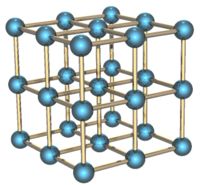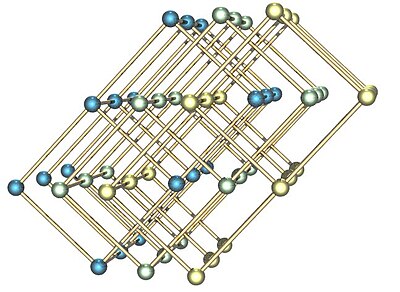Polonium
Template:Elementbox header Template:Elementbox series Template:Elementbox groupperiodblock Template:Elementbox appearance Template:Elementbox atomicmass gpm Template:Elementbox econfig Template:Elementbox epershell Template:Elementbox section physicalprop Template:Elementbox phase Template:Elementbox density gpcm3nrt Template:Elementbox density gpcm3nrt Template:Elementbox meltingpoint Template:Elementbox boilingpoint Template:Elementbox heatfusion kjpmol Template:Elementbox heatvaporiz kjpmol Template:Elementbox heatcapacity jpmolkat25 Template:Elementbox vaporpressure katpa Template:Elementbox section atomicprop Template:Elementbox crystalstruct Template:Elementbox oxistates Template:Elementbox electroneg pauling Template:Elementbox ionizationenergies1 Template:Elementbox atomicradius pm Template:Elementbox atomicradiuscalc pm Template:Elementbox section miscellaneous Template:Elementbox magnetic Template:Elementbox eresist ohmmat0 Template:Elementbox thermalcond wpmkat300k Template:Elementbox thermalexpansion umpmkat25 Template:Elementbox cas number Template:Elementbox isotopes begin Template:Elementbox isotopes decay2 Template:Elementbox isotopes decay2 Template:Elementbox isotopes decay Template:Elementbox isotopes end Template:Elementbox footer
Polonium is a chemical element in the periodic table that has the symbol Po and atomic number 84. A rare radioactive metalloid, polonium is chemically similar to tellurium and bismuth and occurs in uranium ores. Polonium had been studied for possible use in heating spacecraft.
Notable characteristics
This radioactive substance dissolves readily in dilute acids, but is only slightly soluble in alkalis. It is closely related chemically to bismuth and tellurium. Polonium (in common with 238Pu) has the ability to become airborne with ease. More than one hypothesis exists for how polonium does this; one suggestion that that small clusters of polonium atoms are spalled off by the alpha decay.
N. Momoshima, L.X. Song, S. Osaki and Y. Maeda, Environ Sci Technol. 2001, 35, 2956-2960[1] report that microbes can methylate polonium. They also claim that methylcobalamin can also methylate polonium.
Polonium has no stable isotopes and has over 50 potential isotopes. Polonium is extremely toxic and highly radioactive. Polonium has been found in tobacco smoke from tobacco leafs grown at some specific places, as a contaminant[2][3]and in uranium ores. All elements from polonium onward are significantly radioactive.
Solid state form
The alpha form of the Po solid is cubic (Po-Po distance is 3.352 Å), it is a simple cubic solid which is not interpenetrated. A myth has grown up from a single sentence in one of the original papers on the crystal structure as determined by X-ray powder diffraction. Below is shown a diagram of a triple interpenetrated cubic solid, while for Po this is not the structure a reasonable number of real examples of such an interlocking network have been found.
The beta form of polonium is hexagonal, it has been reported along with the alpha form several times in the chemical literature.
Two papers report X-ray diffraction experiments on Po metal.
R.J. Desando and R.C Lange, Journal of Inorganic and Nuclear Chemistry, 1966, 28, 1837-1846.
W.H Beamer and C.R. Maxwell, Journal of Chemical Physics, 1946, 14, 569-569
The first report of the crystal strucutre of Po was done using electron diffraction.
M.A. Rollier, S.B. Hendricks and L.R. Maxwell, Journal of Chemical Physics, 1936, 4, 648-652. if you eat sodium you become vertigo and will walk around like a drunk man and potassiom tasts like sour milk!
Applications
When it is mixed or alloyed with beryllium, polonium can be a neutron source. Other uses;
- This element has also been used in devices that eliminate static charges in textile mills and other places. However, beta sources are more commonly used and are less dangerous.
- Polonium is used on brushes that remove accumulated dust from photographic films. The polonium in these brushes is sealed and controlled thus minimizing radiation hazards.
Polonium-210
This isotope of polonium is an alpha emitter that has a half-life of 138.39 days. A milligram of polonium-210 emits as many alpha particles as 5 grams of radium. A great deal of energy is released by its decay with a half a gram quickly reaching a temperature above 750 K. A few curies (gigabecquerels) of polonium-210 emit a blue glow which is caused by excitation of surrounding air. A single gram of polonium-210 generates 140 watts of heat energy. Since nearly all alpha radiation can be easily stopped by ordinary containers and upon hitting its surface releases its energy, polonium-210 has been used as a lightweight heat source to power thermoelectric cells in artificial satellites. A polonium-210 heat source was also used in each of the Lunokhod rovers deployed on the surface of the Moon, to keep their internal components warm during the lunar nights. Because of its short halflife though polonium-210 cannot provide power for long-term space missions and has been phased out of use in this application.
History
Also called Radium F, polonium was discovered by Maria Skłodowska-Curie and her husband Pierre Curie in 1898 and was later named after Marie's home land of Poland (Latin: Polonia). Poland at the time was under Russian, Prussian and Austrian domination, and not recognized as an independent country. It was Marie's hope that naming the element after her home land would add notoriety to its plight. Polonium may be the first element named to highlight a political controversy.
This element was the first one discovered by the Curies while they were investigating the cause of pitchblende radioactivity. The pitchblende, after removal of uranium and radium, was more radioactive than both radium and uranium put together. This spurred them on to find the element. The electroscope showed it separating with bismuth.
Occurrence
A very rare element in nature, polonium is found in uranium ores at about 100 micrograms per metric ton (1:1010). Its natural abundance is approximately 0.2% of radium's.
In 1934 an experiment showed that when natural bismuth-209 is bombarded with neutrons, bismuth-210, which is the parent of polonium, was created. Polonium may now be made in milligram amounts in this procedure which uses high neutron fluxes found in nuclear reactors.
Isotopes
Polonium has many isotopes all of which are radioactive. There are 25 known isotopes of polonium with atomic masses that range from 194 u to 218 u. Polonium-210 is the most widely available. Polonium-209 (half-life 103 years) and polonium-208 (half-life 2.9 years) can be made through the alpha, proton, or deuteron bombardment of lead or bismuth in a cyclotron. However these isotopes are expensive to produce.
The great radioactivity of polonium and its immediate neighbors to the right on the periodic table, and its stark contrast with lead and bismuth, is due to the great instability of nuclei containing 84 or more protons. Nuclei that contain 128 neutrons along with 84 or more protons are especially unstable. Curiously, thorium-232 and uranium-238 are in an "island of stability" which renders them stable enough to be found in large quantities in nature, but heavier nuclei are more and more affected by spontaneous fission.
Precautions
Polonium is a highly radioactive and toxic element and is dangerous to handle. Even in milligram or microgram amounts, handling polonium-210 is very dangerous and requires special equipment used with strict procedures. Direct damage occurs from energy absorption into tissues from alpha particles.
The maximum allowable body burden for ingested polonium is only 1100 becquerels (0.03 microcurie), which is equivalent to a particle weighing only 6.8 × 10-12 gram. Weight for weight polonium is approximately 2.5 × 1011 times as toxic as hydrocyanic acid. The maximum permissible concentration for airborne soluble polonium compounds is about 7,500 Bq/m³ (2 × 10-11 µCi/cm³).
References
External links
Template:Commons Template:Wiktionary
ast:Poloniu ca:Poloni cs:Polonium co:Poloniu da:Polonium de:Polonium et:Poloonium el:Πολώνιο es:Polonio eo:Polonio fa:پولونیوم fr:Polonium gl:Polonio (elemento) ko:폴로늄 hr:Polonij io:Polonio id:Polonium is:Pólon it:Polonio he:פולוניום ku:Polonyûm lv:Polonijs lb:Polonium lt:Polonis hu:Polónium nl:Polonium ja:ポロニウム no:Polonium nn:Polonium oc:Polòni pl:Polon pt:Polônio ru:Полоний simple:Polonium sr:Полонијум sh:Polonijum fi:Polonium sv:Polonium th:พอโลเนียม uk:Полоній zh:钋

